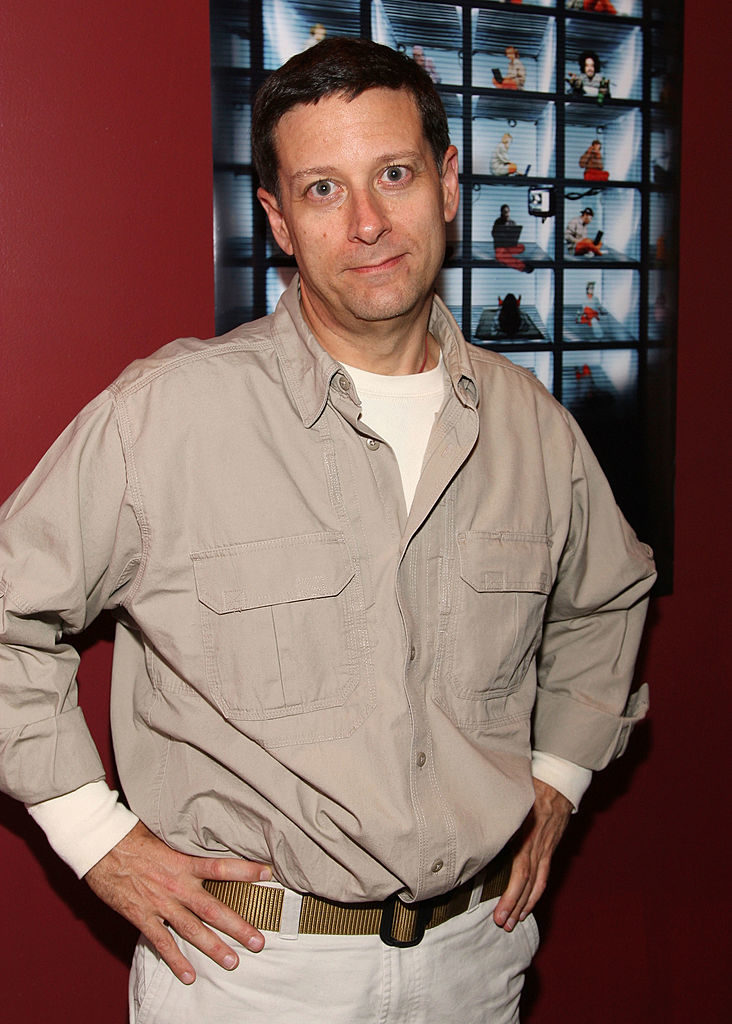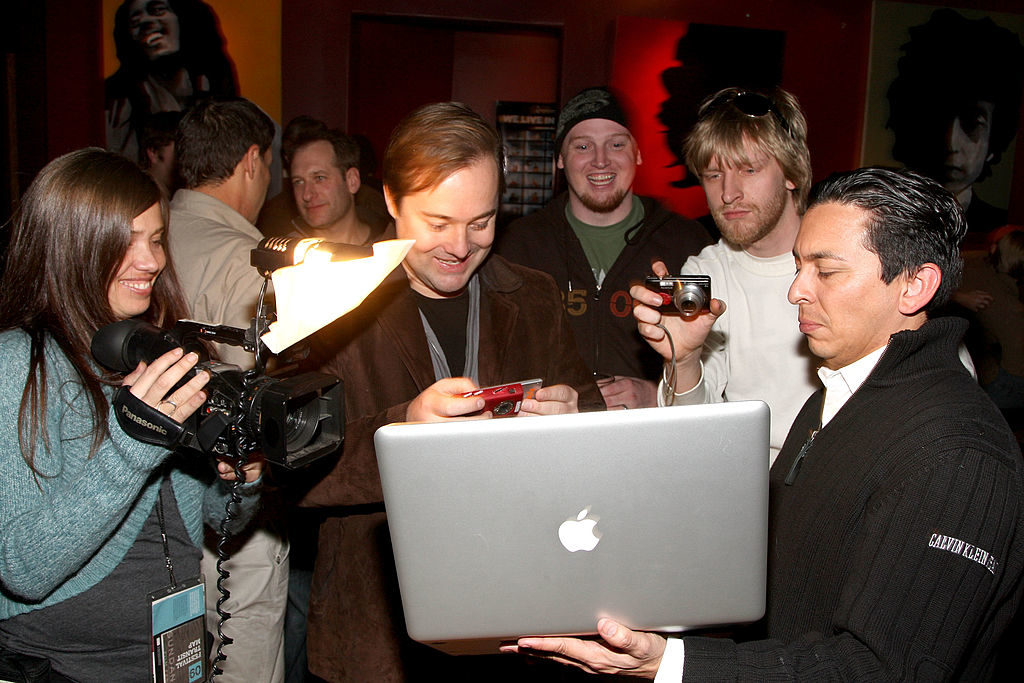Art World
Anthony Haden-Guest on What Happens When Fake News Hits the Art World
There is little certainty in a post-truth art world. Just ask the 'Warhol of the Web.'

There is little certainty in a post-truth art world. Just ask the 'Warhol of the Web.'

Anthony Haden-Guest

Josh Harris, aka “The Warhol of the Web,” the Internet pioneer who put high-tech to ambitious art uses in downtown New York in the late 1990s, and who made and lost $80 million in so doing, is under scrutiny again. Harris, who now lives in a cheap Las Vegas apartment, told Britain’s Financial Times that he was sure he had been under surveillance by the Feds since he filmed a performance by Gelatin, a four man Vienna-based collective, on the 21st floor of the World Trade Center in March 2000. In an online follow-up another Brit paper, the Daily Mail, specified that the performance had involved a “mysterious art installation with ties to 9/11.”
The performance? The art collective Gelatin—Ali Janka, Florian Reither, Tobias Urban and Wolfgang Gantler—covertly removed a window of the World Trade Center, installed a balcony, and stood on it, one at a time, at six in the morning. It was a 19-minute operation, part of which Harris filmed from a helicopter as a group of aficionados watched from across the street in a suite at the Millennium Hotel. David Leslie, the performance artist, aka “The Impact Addict,” remembers seeing Leo Koenig, whose gallery was Josh Harris’s neighbor on lower Broadway, and who had introduced them. Leslie was not impressed by the balcony. “It looked like a fire extinguisher,” he told me. A show doubling as a documentation of the project was to open at Leo Koenig’s gallery on September 11, 2001. Yes, 9/11. “Only a few people were there,” says the artist Alfredo Martinez. “They didn’t close the area down until a few days later.”
The horrors first, then the crazy stuff: that’s how it goes these days. Conspiratorial thinking of the Fake News variety has again reared its head into matters of the art world. The Mail’s illustrations of the World Trade Center project included a diagram hand-drawn by Gelatin of the floor space, and this can also be found on an online conspiracy site whose version is headlined Preparing the WTC for Destruction and features the creepily deadpan absurdities characteristic of the Fake News genre; while on another site a video references the “Israeli military and intelligence operatives posing as ‘art students.’” Well, an event is just an event—but two make a pattern. The Podesta emails released by Wikileaks include one from Marina Abramovic who mentions her 1996 performance, Spirit Cooking. Whooosh! She was swept into Pizzagate as a cannibal Satanist in Hillary Clinton’s child trafficking ring. You could call it a tribute to the heft of the contemporary art world that the Fake Newsies find it a useful resource, but, actually, simulation, dissimulation, and the hoax have been part of its armory since long before the young Michelangelo treated his Sleeping Cupid with acidic mud, hoping to pass it off as an antiquity.
For his part, Josh Harris grew up in Ventura, California, the son of a usually absent CIA father. He arrived in New York in 1984, took an entry-level job in a tech company, and went on to start two dot-coms: Jupiter, which number-crunched data to predict trends on a baby phenomenon—the Internet; and Pseudo, an online TV network. This activated the buzz machine and Jupiter went public, making Harris a dot-com millionaire.
And one with art ambitions. The new tech money had been an art world disappointment so far. A few individuals—Bill Gates, Paul Allen—would become serious collectors, but most clearly felt that what was on their screens was at least as smart as anything an artist could come up with. Not so, Josh Harris and a lively boho scene came into being in his lower Broadway townhouse. Quiet: We Live In Public, a project intended to showcase his vision of the human future, and which he launched early in December of 1999, featured a hundred volunteers living in capsules on three floors of his building, where their activities—in showers, bathrooms, beds, wherever—were videotaped 24/7. So Quiet was before reality TV and way better, and it was busted on the cusp of the millennium by the NYPD, perhaps suspecting it was a doomsday cult. It had cost over $2 million and had been a huge success. That was that, though. The dot-coms were teetering and the crash swallowed much of what remained of Josh’s moolah. He sold up and left the city for an apple orchard upstate. I had got to know him fairly well and we spoke. But then the orchard went, too. I would hear rumors of another start-up and complicated travels.
In 2009, We Live in Public, a documentary about Harris and his Quiet project, assembled from years of footage by Ondi Timoner, won the Grand Jury Prize in the U.S. Documentary category at Sundance. The day it was to be awarded, Josh Harris called. I asked why he was in New York, and not Utah, but he just said he wanted to talk to me. We met at the bar in Indochine. He wanted to talk about Gelatin (and the World Trade Center project). It happened that I had met Florian Reither of Gelatin not so long before. I mentioned this. Harris intimated that Gelatin, who had changed its name in 2005, had been involved in what had taken place at the World Trade Center—but he volunteered no details. He had never been a fellow easy to pin down, but now he was unreadable. Just a few months before he had written to the New York Times from his current enterprise in Ethiopia to say of his dot-coms that “Pseudo was a fake company” and that his complete business was “an elaborate piece of performance art.”

A general view of the party for the screening of “We Live In Public” during the 2009 Sundance Film Festival. Photo by Bryan Bedder/Getty Images.
That October I went to the opening of an exhibition of Damien Hirst paintings at the Wallace Collection in London. Florian Reither was there. Unlike Harris, he spoke of the World Trade Center project freely. “A lot of people were nervous about the new millennium. For us we said, ‘It’s a zero year. We can do anything!’ So for us it was like a year of doing things without taking them too serious.”
Reither got a sense of what they were going to do while they were landing, “I already had this vision in the plane, landing in Newark. Looking over to the World Trade Center, I had this idea like we’re going to put something on this thing.”
They moved in. “There were about 20 artists on [roughly] a third or a quarter of the 91st floor. There was no floor, no ceiling. It was just like an open space. Because they usually rent it to companies. And once we decided we would do the balcony, we had to come up with a strategy to camouflage it from the other artists. So we found cardboard boxes, took them up there and built cardboard walls. We built a secret opening in these boxes. And inside we started building the balcony. We built it out of wood. And in the back we had a counterweight. We had a box filled with sand.”
They removed the window using automotive technology and pushed the balcony out. And, hey, presto!
“We had a friend in the hotel room and when the people left he took their cameras and took out the film,” he says. “Because we didn’t want anybody to wander around with images of the balcony.” He added that they hadn’t known Josh Harris had kept a copy of the video. “We wanted to keep control of this,” he said.
That was possible back then. “It was before there were digital cameras,” Florian Reither said. “I mean there were. But nobody had a digital camera.”
As for Fake News: it was an amusement to be found in jokey mags like the National Enquirer. That, of course, was back then.